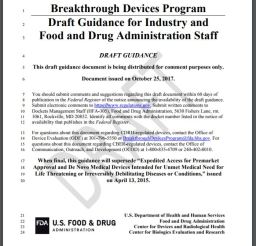

Deciding When to Submit a 510(k) for a Change to an Existing Device
510(k)s for changes to a legally marketed device should consider Quality System (QS) regulation
- For some types of changes submission of new 510(k) not required
- Reliance on existing QS requirements is the least burdensome approach
Guiding Principles
- Changes made with intent to significantly affect safety or effectiveness
- Initial risk-based assessment
- Unintended consequences of changes
- Use of risk management
- Role of testing in evaluating effect on safety and effectiveness
- Evaluating simultaneous changes
- Appropriate comparative device and cumulative effect of changes
- Documentation requirement
- 510(k) submissions for modified devices
- Substantial equivalence determinations
Overview
- Labeling Changes
- Technology, Engineering, and Performance Changes
- Materials Changes
- Technology, Engineering, Performance, and Materials Changes for In Vitro Diagnostic Devices
- Considerations for Risk-Based Assessments of Modified Devices

Deciding When to Submit a 510(k) for a Software Change to an Existing Device
When software (including firmware) change to medical device may require 510(k)
- Enhance predictability, consistency, transparency of the “when to submit”
- Provide a least burdensome approach, regulatory framework, policies, practices
Guiding Principles
- Changes made with intent to significantly affect safety or effectiveness
- Initial risk-based assessment
- Unintended consequences of changes
- Use of risk management
- Role of testing in evaluating effect on safety and effectiveness
- Evaluating simultaneous changes
- Appropriate comparative device and cumulative effect of changes
- Documentation requirement
- 510(k) submissions for modified devices
- Substantial equivalence determinations
Additional guidance
- Use flowchart in concert with the Guiding Principles
- With multiple changes, use all applicable parts of flowchart and companion text, including the Guiding Principles

Clinical Drug Interaction Studies — Study Design, Data Analysis, and Clinical Implications
Conduct of clinical studies to evaluate Drug-Drug Interaction (DDI) potential
- Timing and design of clinical studies
- Interpretation of study results
- Options for managing DDIs in patients
Goals of studies to determine
- Whether investigational drug alters pharmacokinetics of other drugs
- Whether other drugs alter pharmacokinetics of investigational drug
- Magnitude of changes in pharmacokinetic parameters
- Clinical significance of observed or expected DDIs
- Appropriate management strategies for clinically significant DDIs
Considerations
- Timing, Types, Design and conduct of DDI sudies
- Stand-Alone and Nested Prospective DDI Studies
- CYP-Mediated Interactions
- Transporter-Mediated Interactions
- Reporting and Interpretations
- Labeling recommendations
 Breakthrough Devices Program
Breakthrough Devices Program
Breakthrough Devices Program for certain medical devices for life-threatening or irreversibly debilitating diseases or conditions
- Expedites development, assessment, FDA review, while preserving statutory standards
- Supersedes the Expedited Access Pathway (EAP)
Considerations
- Program Principles
- Program Features
- Designation Request
- Designation Review Process
- Designation Withdrawal
Manufacturers Sharing Patient-Specific Information from Medical Devices with Patients Upon Request
Patients play an active role in their own healthcare
- May request personal information that has been recorded, stored, processed, retrieved, and/or derived from marketed medical device
- Sharing “patient-specific information” upon request may assist in being more engaged with healthcare providers in making sound medical decisions
Categories of patient-specific information for sharing
- Data healthcare provider inputs in device to record status and ongoing treatment
- Information stored by device to record usage, alarms, or outputs (e.g., pulse oximetry data, heart electrical activity)
- Case logs entered into device by healthcare provider

De Novo Classification Process (Evaluation of Automatic Class III Designation)
To provide guidance on the process for the submission and review of a De Novo classification request
- for cases where there is no predicate device or has received an NSE determination on a 510(k) submission
- specific device and device type is classified in class I or class II
- publish a notice in the Federal Register announcing classification and controls necessary to provide reasonable assurance of safety and effectiveness

Acceptance Review for De Novo Classification Requests
To explain FDA procedures and criteria for acceptability for substantive review of De Novo classification request
- Making “Accept” or “Refuse to Accept” (RTA) decisions
De Novo Acceptance Review Policies and Procedures
- Acceptance Review Policies and Procedures
- FDA Review Clock
- Notification of Acceptance Review Result
- Refuse to Accept Principles
Checklist Acceptance Review
- Organizational Elements
- Elements of a Complete De Novo Request (RTA Items)
- Applying the Checklist of RTA Items
- Elements Marked as “Not Applicable” (N/A)
- Adequacy of Information
- Elements Marked “No”
Recommended Content Checklist
- Purpose
- Prior Submission(s) Relevant to the De Novo Request Under Review
Checklists
- Acceptance Checklist for De Novo Classification Requests
- Recommended Content Checklist for De Novo Classification Requests
